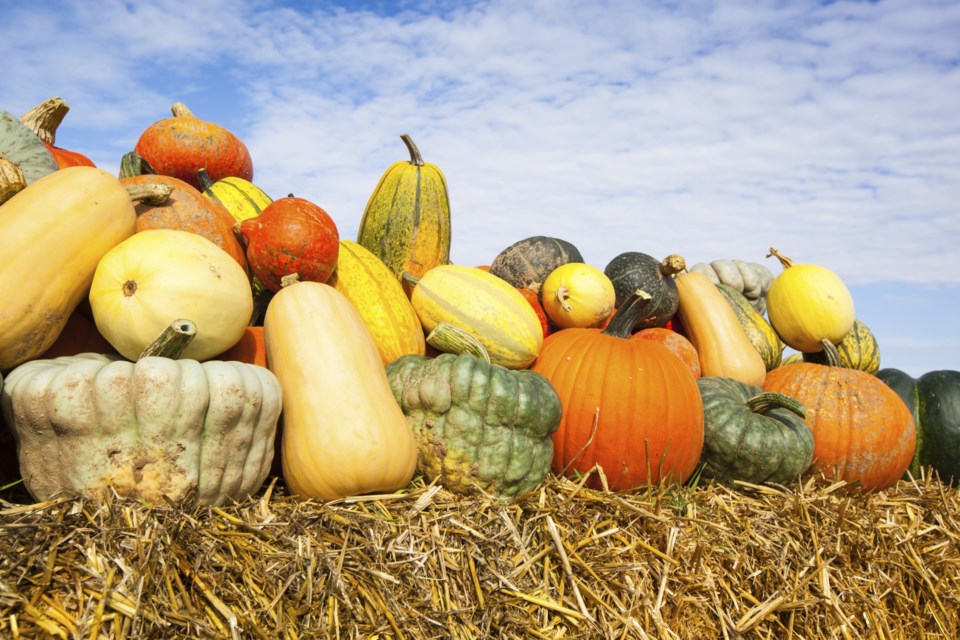Halloween is here! Time to dress up as your alter egos drink some ale or indulge in some sweet treats collected from friendly strangers.
Whatever your vice, many of us will indulge in the long-standing tradition of carving a huge orange pumpkin decorating with a light and displaying for all to see. This tradition has been said to originate in Ireland where they originally carved turnips.
In our modern world, a growing number of people are stepping away from the familiar faces of giant pumpkins and decorating with other types of squash, and who could blame them? There are so many different types of beautiful winter squash and pumpkins that can be used long after the pumpkin carving is done, even the good ol’ classic pumpkin can be destined for so much more than compost come Nov 1.
There are countless varieties of pumpkins and winter squash that can be carved and then transformed into soups, stews, roasted seeds, planters, bird feeders, feed for animals, broth and so forth post carving. But before you decide on what will do with your colourful squash/pumpkin, it's a good idea to think ahead as you will want to use your pumpkin or squash as close to the date that you carved it to avoid getting sick as it will start to decompose very quickly. Make sure to wash your pumpkin quite well if you decide to cook it and another great tip to make your pumpkin or squash last longer is by carving just the skin and not hollowing it out.
Winter squash are known for their richness in anti-inflammatory nutrients which include omega 3 and beta-carotene. These are great for protecting your immune system from the colds and flu's which are going around. Winter squash are also great because they are so versatile and inexpensive not to mention they are in season right now and in great colourful abundance!
Then there are the good old fashion pumpkin seeds. These inner gems are known for their abundance of zinc (awesome for your prostate, fellas) but they are also high in antioxidants and vitamin E. Also they’re delicious and a great side to all the craft pumpkin ale that’s now in season – just roast with some olive oil and spices and enjoy the party of flavour in your mouth!
Here is a list of some great variations to the classic:
Acorn squash.Looks like a weird one to carve but it’s doable. They are also great for steaming, roasting, mashing and sautéing and the smaller ones are great for stuffing.
White pumpkin. These are best used for decorations and carving, however their heirloom counterparts are a sweet and delicious eat.
Butternut squash. The sweetest of the winter squash, and can still be used for carving. They are best sourced for soups, purees, roasting and sautees.
Sugar pie and sweet pumpkin.Yes, pumpkins are also a winter squash! Of course we know their main use for this time of year for carving, and although the flesh is a bit flavourless, adding the perfect spice will take it up a knotch.
Kabocha Squash. With a great nutty flavour and a tough rind like skin, this Japanese squash is extremely versatile, being able to be cooked either which way, skin and all!
Roasted Pumpkin Seeds
1.Separate the seeds from the flesh and strings.
2.Rinse the seeds under cold water.
3.Soak the seeds in salt water overnight-This will remove phytic acid, an enzyme inhibitor and anti-nutrient thatcan irritate your stomach. Removing them allows the production of more vitamins in the seeds and makes them more digestible.
4.Dry the seeds off with a hand towel and add spices of your choice. You can add Salt, Pepper, Cayenne, Basil, Turmeric or even curry powder.
5. Drizzle with olive oil (1tsp for every cup of seed) and mix together.
6.On a baking sheet/Cookie sheet, bake seeds at 350F for 20-30 min checking and stirring every 5-10 minutes.
7. Cool down before eating, then enjoy a crunchy



